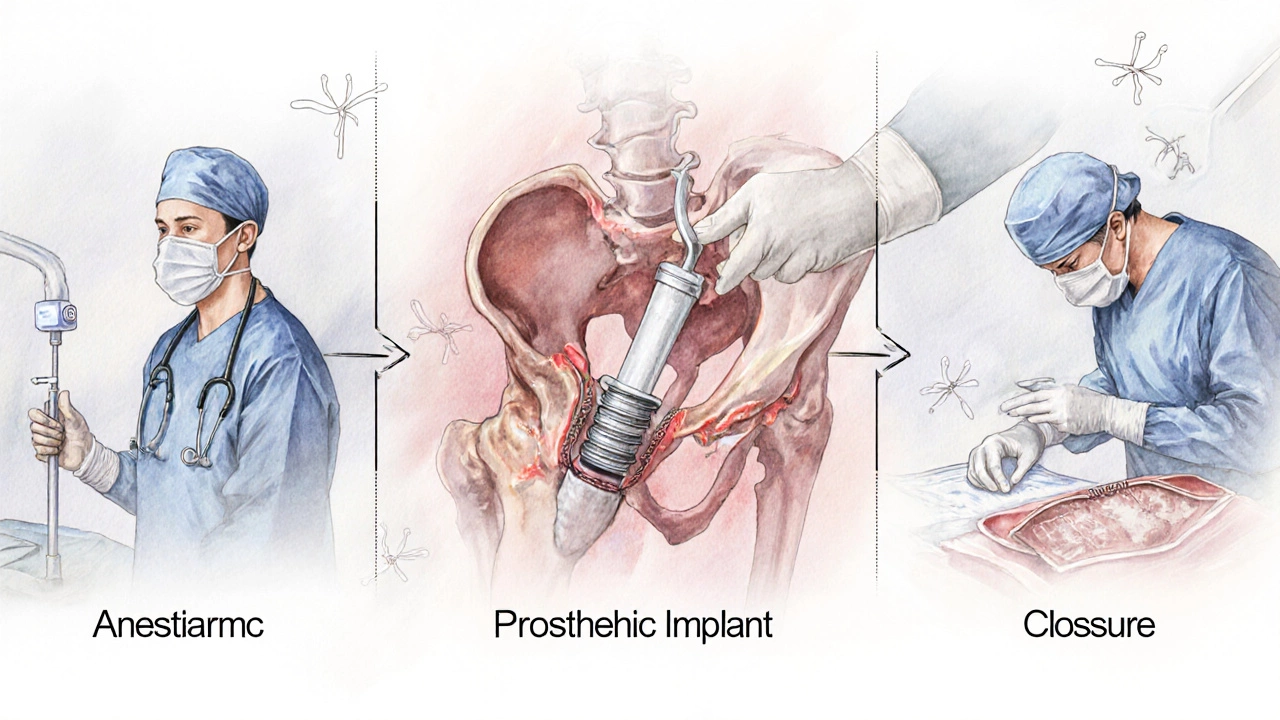How Many Hours Does a Bone Surgery Take? Real Times for Common Procedures
 Nov, 15 2025
Nov, 15 2025
Bone Surgery Time Calculator
Estimate Your Surgery Duration
Select your procedure type and key factors to get an estimated surgery time range based on medical guidelines.
Estimated Surgery Time
This estimate includes preparation, surgery, and closure time (not recovery)
What your time includes:
When you or someone you love is facing bone surgery, the biggest question isn’t always about the risks or the recovery-it’s often just: how long will this take? You’re not just worried about the knife. You’re thinking about missing work, caring for kids, sitting in a hospital waiting room for hours, and whether the surgeon will be able to fix it right the first time. The truth? There’s no single answer. Bone surgery isn’t like a dental filling. One size doesn’t fit all. But knowing what to expect can take the edge off the fear.
It Depends on the Type of Bone Surgery
A simple fracture repair in a child’s arm can be over in under an hour. A full hip replacement in an older adult with osteoporosis might take three hours or more. The time isn’t just about cutting and sewing. It’s about positioning, imaging, bone grafting, implant placement, checking alignment, and making sure everything holds.
Here’s what you’re actually looking at for common procedures:
- Simple fracture repair (like a wrist or ankle): 45 to 90 minutes. If the bone is clean and in place, surgeons can often use pins or plates without needing to open the area too wide.
- Complex fracture (like a broken femur or pelvis): 2 to 4 hours. These involve realigning shattered bone, using rods or large plates, and sometimes multiple incisions. Blood loss and swelling add time.
- Knee replacement: 1.5 to 3 hours. Modern techniques are faster, but if there’s severe arthritis, deformity, or prior surgeries, it can stretch to 3.5 hours.
- Hip replacement: 1.5 to 3 hours. Most are done in under two, but if the patient has had infections or previous implants, the surgeon has to remove old hardware first-adding time.
- Spinal fusion (for a broken vertebra or degenerative disease): 3 to 6 hours. This isn’t just one bone. It’s multiple levels, screws, rods, bone grafts, and nerve monitoring. A single-level fusion might take 3 hours. Three levels? You’re looking at 5 or 6.
- Revision surgery (fixing a failed bone implant): 3 to 5 hours, sometimes longer. Scar tissue, broken screws, and infection control make this much more complex than the first go-around.
What Happens During the Time?
People think surgery time = cutting time. It’s not. The clock starts when you roll into the OR and ends when you’re wheeled out. Here’s what fills those hours:
- Prep and anesthesia: 15 to 45 minutes. This includes checking your chart, placing IVs, giving spinal or general anesthesia, and positioning you on the table. You might be asleep before the first incision.
- Incision and exposure: 10 to 30 minutes. Cutting through skin, muscle, and fascia to reach the bone. In some cases, like a hip, the surgeon has to carefully move muscles aside without damaging nerves.
- Bone work: 30 minutes to 2+ hours. This is the core. Cutting, reshaping, drilling, inserting screws, plates, rods, or implants. If the bone is crushed or infected, cleaning it out takes longer.
- Imaging during surgery: 5 to 20 minutes. Surgeons use X-rays or fluoroscopy to confirm alignment. If the first placement isn’t perfect, they adjust-adding minutes.
- Closure and dressing: 15 to 30 minutes. Sewing muscle, skin, and applying sterile dressings. Some surgeons use glue or staples instead of stitches.
And don’t forget: if something unexpected comes up-like a broken screw, a blood vessel that bleeds harder than expected, or a nerve that’s swollen-you’re looking at extra time. Surgeons don’t rush. They fix it right.
Why Do Some Surgeries Take Longer Than Others?
It’s not just about the bone. It’s about the person.
- Age and bone quality: Older patients often have brittle, osteoporotic bone. Screws don’t hold as well, so surgeons need to use more or larger implants, or add bone grafts. That adds time.
- Previous surgeries: Scar tissue from old operations makes everything harder. It’s like trying to rebuild a house inside a maze of old wiring and pipes.
- Body weight: Heavier patients have more tissue to move through. It takes longer to reach the bone, and positioning becomes trickier.
- Infection or prior implant failure: If there’s an infection, the surgeon has to remove all hardware, clean the area thoroughly, and sometimes delay the new implant. That can double the time-or split it into two surgeries.
- Surgeon experience: A surgeon who’s done 500 hip replacements will move faster than someone doing their 50th. But speed isn’t everything. Experience means better decisions, fewer mistakes, and less need to redo things.

What About Emergency Bone Surgeries?
Emergency bone surgery-like after a car crash or fall from height-is different. The goal isn’t perfection. It’s saving the limb and preventing infection. Surgeons often do a temporary fix first: a splint, external frame, or temporary rod. That might take 45 minutes to an hour. Then, days or weeks later, they come back for the definitive repair, which is the longer, more detailed surgery.
In trauma cases, time matters more than precision-at first. You don’t want a dead limb or sepsis. So surgeons work fast, but smart. They know when to pause and when to push.
What You Can Do to Help Keep Surgery Time Short
You can’t control the surgeon’s skill, but you can control your prep:
- Stop smoking. Smoking slows bone healing and increases infection risk. If you smoke, quitting even two weeks before surgery helps.
- Manage your weight. If you’re overweight, losing even 5-10 pounds reduces pressure on joints and makes surgery easier.
- Control blood sugar. Diabetics heal slower. High sugar levels increase infection risk. Work with your doctor to get HbA1c under control before surgery.
- Bring your full medical history. Tell the team about every medication, supplement, and past surgery. Missing one detail can lead to delays or complications.
- Ask questions. Know what procedure you’re getting. Ask: “What’s the expected time?” “What could make it longer?” “Will I need a second surgery?”

What Happens After the Surgery?
The surgery ends when you’re wheeled out. But the real clock starts then.
Most bone surgeries require 2 to 6 hours in recovery before you’re stable enough to go to a hospital room. You’ll be monitored for blood pressure, pain, and circulation. Some patients go home the same day. Others stay overnight-or longer-if the surgery was complex or they’re older.
Recovery time is different from surgery time. A wrist fracture might mean 6 weeks in a cast. A hip replacement could take 3 to 6 months to feel normal. But that’s not the surgeon’s clock. That’s your body’s.
When Should You Worry About Long Surgery Time?
Long surgery isn’t always bad. But if the procedure is taking significantly longer than expected, it’s worth asking:
- Is there a complication? (Bleeding, nerve issue, implant problem)
- Is the surgeon having trouble finding the right spot?
- Are they switching plans mid-surgery?
Most of the time, delays are normal. But if the surgical team doesn’t give you updates after 30-45 minutes past the expected time, it’s okay to ask a nurse: “Is everything okay? We’re a bit past the estimate.”
Good teams will tell you. Bad teams won’t. You deserve to know.
Final Thought: It’s Not Just About Time
Hours matter. But outcomes matter more. A 3-hour surgery that fixes your hip for life is better than a 90-minute one that needs redoing in two years. Don’t chase speed. Chase confidence.
Ask your surgeon: “What’s your success rate with this procedure?” “How many of these do you do a year?” “What’s the plan if something goes wrong?”
Those answers tell you more than any clock ever could.
How long does a broken leg surgery take?
A broken leg surgery, like a femur fracture repair, usually takes 2 to 4 hours. The time depends on whether the bone is shattered, if there’s damage to surrounding tissue, and if a rod or plate is needed. Simple fractures with clean breaks can be fixed in under 2 hours. Complex cases with multiple fragments or infection can take longer.
Is 4 hours too long for a bone surgery?
Not at all. Four hours is common for joint replacements, spinal fusions, or complex fracture repairs. Surgeries for hips, knees, and spines often take this long-even with experienced teams. What matters is that the surgeon is focused on getting it right, not rushing. Shorter doesn’t mean better if the result isn’t stable.
Can bone surgery be done in under an hour?
Yes, for simple cases. A child’s broken wrist, a clean finger fracture, or a small bone graft can be done in under 60 minutes. These are low-risk, straightforward procedures. But if the bone is broken in multiple places, or if you’re an adult with poor bone quality, surgery will take longer.
Why does hip surgery take longer than knee surgery?
Hip surgery often takes longer because the joint is deeper, surrounded by more muscle, and harder to access. The surgeon has to carefully move muscles aside to reach the ball-and-socket joint. Knee surgery is more exposed, and modern tools allow faster removal of damaged bone. But both typically take 1.5 to 3 hours-timing varies by patient and complexity.
Does anesthesia add time to bone surgery?
Anesthesia doesn’t add to the actual bone work, but it adds 15 to 45 minutes to the total time in the operating room. That’s the time it takes to put you under, position you safely, and monitor your vital signs before the surgeon starts. It’s part of the process, not extra. Once you’re asleep, the surgical team takes over.